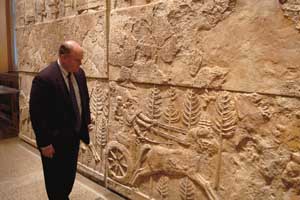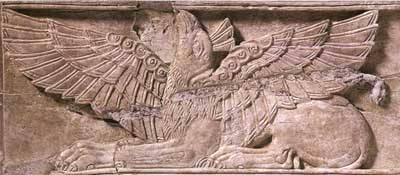Oriental Institute to feature ancient, global society in new exhibition: Empires in the Fertile Crescent
By William HarmsNews Office
 Gil Stein, Director of the Oriental Institute, views the relief of King Sargon II in the exhibition. The walls of palaces of neo-Assyrian kings were lined with carved slabs of stone showing the king and his court. This example from the private chambers of the palace at Khorsabad (710 B.C.) shows the king riding through a pine forest in his chariot, protected from the heat of the sun by a parasol-like sunshade an attendant holds above the king’s head.  Much of the art from the Fertile Crescent exhibits a mixture of styles drawn from different regions and peoples. The material used for the sculpture of a sphinx is the rough-textured basalt found in southeastern Anatolia and favored by the neo-Hittite states (ninth century B.C.). The triangular face of this sphinx is common to the region, but the curled hair on the shoulders is drawn from Egyptian prototypes. The sphinx was part of a larger object, perhaps the arm of a stone throne.  The cuneiform text on this clay prism (ca. 690 B.C.) documents the spread of the Assyrian Empire, including Sennacherib’s campaigns against the neo-Hittite states in Turkey and Sidon (Lebanon), and the siege of Jerusalem, then under the rule of Hezekiah.  Above is a 13th-century B.C. carved relief of a griffin, excavated at Megiddo, Israel. | |
Visitors will get a rare look at one of the most important geographic regions in the ancient Near East beginning Saturday, Jan. 29, with the opening of “Empires in the Fertile Crescent: Ancient Assyria, Anatolia and Israel,” the newest galleries at the University’s Oriental Institute Museum.
The galleries showcase artifacts that illustrate the power of these ancient civilizations, including sculptural representations of tributes demanded by kings of ancient Assyria, and some sources of continual fascination, such as a fragment of the Dead Sea Scrolls—one of the few examples in the United States.
The galleries also contain artifacts connected with the beginning of two important eras, the Bronze Age and the later Iron Age, as well as artifacts from Megiddo, a site that is figuratively connected with the end of all eras—the site referred to in the Bible as Armageddon.
James Henry Breasted, the founder of the Oriental Institute, coined the term “Fertile Crescent” for the region that extends from the fertile plains of Mesopotamia, across the Taurus Mountains of Anatolia, and down the Mediterranean coast to Israel and Palestine. The galleries include objects from 6000 to 600 B.C. from ancient Assyria, Anatolia (modern-day Turkey), Syria and Israel/Palestine, which were part of the Fertile Crescent.
The cultures vied for domination and in many ways influenced one another’s literary, religious and artistic development. Among the major empires were the Assyrians; the Hittites, who gathered their strength in Anatolia and extended their control to the Fertile Crescent; and the Egyptians, who controlled part of the region through military force and their cultural influence.
“These interactions were part of what we would call today a global society,” said Gil Stein, Director of the Oriental Institute. “The new galleries show how the various powers interacted, adopted each other’s styles, respected the accomplishments and cultures of other people, and ultimately developed common perspectives, many of which can be followed as visitors look at the galleries’ artifacts.”
The new exhibition is part of a multi-year renovation of the Oriental Institute Museum. “Visitors can revisit the geographical regions of the Fertile Crescent as they walk through our galleries,” said Geoff Emberling, Director of the Museum.
“Visitors begin in Assyria, move across Anatolia and down the Mediterranean coast to the land of ancient Israel. The galleries also trace the conquests of the Assyrian Empire across the Near East and follow their trail to Israel.”
The new exhibition opens in the Dr. Norman Solhkhah Family Assyrian Empire Gallery with finely carved reliefs from the private section of an 8th-century B.C. Assyrian palace, including several that show dignitaries from the court of King Midas in modern-day Turkey bringing tribute to the court of King Sargon II of Assyria.
“They are not bringing gold, but leading horses, which were very valuable to an empire that grew through warfare,” Emberling said. The Assyrians were the first to use iron extensively in weapons, and ingots from the birth of the Iron Age (about 900 B.C.) are on display in a nearby case.
In the Henrietta Herbolsheimer, M.D., Syro-Anatolian Gallery, another case is devoted to objects of bronze such as tools, weapons and figurines. “Among the greatest treasures of the Oriental Institute is the group of figurines from Tell Judaidah in southeastern Turkey. These remarkable sculptures of men and women dating to 3000 B.C. are the world’s earliest known artifacts made of true bronze, which is an alloy of copper and tin.
“They are the forerunners of the great variety and quantity of bronze figurines and tools that are characteristic of the fully developed Bronze Age, which began in the early third millennium and was one of the most important technological and economic developments in the ancient world,” said Stein.
Like the bronzes and the Assyrian reliefs, most of the other 1,000 artifacts in the 3,700-square-foot exhibition space were excavated by Oriental Institute archaeologists. Among the rare items they brought back are fragments of a monumental statue of a king of the Neo-Hittite cities that held power in northern Syria and southeastern Anatolia in the ninth century B.C.
The fragments include a head with a curled coiffure and portions of what may have been parts of his throne. Also on display is a monumental column base of basalt, carved with intricate floral designs, which once stood in the king’s palace.
Before visitors turn a corner to enter the Egyptian gallery, they can examine artifacts in the Haas and Schwartz Megiddo Gallery from another important Oriental Institute excavation, the dig at Megiddo that covered a span in time from 5000 to 600 B.C. Each layer was carefully uncovered to reveal successive cultures that dominated the city, which is in modern Israel. Many of the items from Megiddo have never been exhibited before.
Megiddo, like the rest of the Fertile Crescent, was a crossroads of cultures. Excavations unearthed altars used by non-Jewish peoples (the Canaanites) as well as a gold figure of El, their principal god.
The Israelites, who emerged as the dominant people of that region in about 975 B.C., are documented by many objects of daily life, including a large stamp engraved with a biblical text and an ossuary (box for bones) inscribed in Hebrew.
Probably the most spectacular portion of the Megiddo gallery, however, is the section with the Megiddo ivories. These exquisitely carved pieces of elephant tusks were inlays in furniture, and a particularly large piece was made into a game board.
“The ivories are carved in different styles—Egyptian, Mycenaean Greek and local Canaanite—and show how connected Megiddo was to a larger world during the Late Bronze Age,” Emberling commented.
The new galleries are made possible by the generosity of several major donors whose names are included as part of the exhibition.
![[Chronicle]](/images/sidebar_header_oct06.gif)